
4 minute read
Economic Update Q3
We are only a few months removed from the final provincial budget landing. However, in this quick-changing, pandemic-driven economy, it feels like much longer. A lot has changed since provinces tabled their 2021/22 budgets, much of it positive as relates to future revenue streams.
Vaccination rates have surged over the spring, case counts throughout most of the country are dropping, commodity prices are generally higher and the US economy is rebounding quickly to support exports. The delta variant is a concern that prevents us from raising our GDP forecasts even higher. However, even with that caution, all provinces should see economic growth and by extension provincial revenues, handily beat budget forecasts.
Advertisement
Those that were most cautious in their planning include British Columbia. But, with provincial bond spreads tracking rising commodity prices closely, that good news appears to be largely priced in. Since budgets were tabled, spreads have outperformed significantly, which is the ‘benchmark’ most provincial names trade off-of, owing to the size of the province’s borrowing program and liquidity of the underlying debt.
A LONG ROAD BACK?
Throughout the pandemic so far, the federal government has stepped up to the plate and provided provinces with extra transfers to support municipalities, cover increased health care costs and compensate for lost revenues. Because of that, even though the aggregate provincial deficit rose from just under 1% of GDP in 2019/20 to almost 4% in 2020/21, that is obviously much less severe than the 16% of GDP deficit at the Federal level.
That support from the federal government will continue in the current fiscal year. And, because a $7.2bn support package announced in late March would not have been included in many provincial budget plans, there is already scope for this year’s provincial deficits to be somewhat lighter than planned.
Although we’ll argue that the actual results should be better, on aggregate the budgets planned for a slower path back to either balance, or at least the sort of deficits that were run before Covid-19 struck (Chart 1, right). Indeed, even the
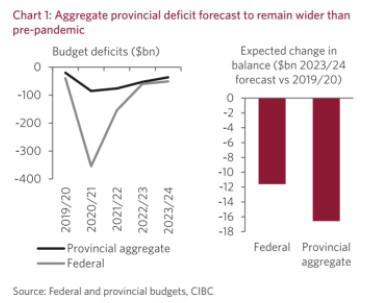
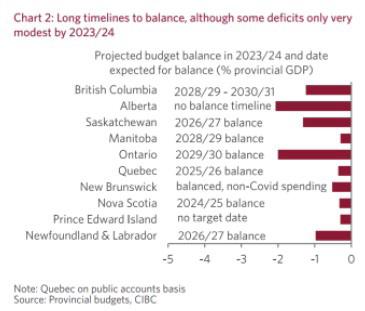
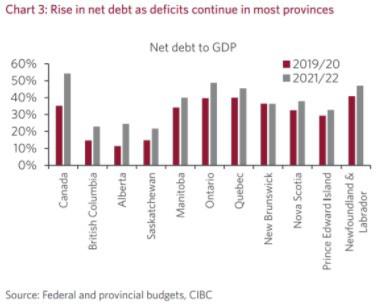
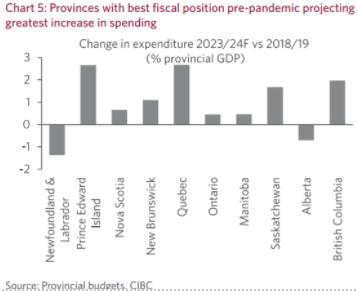
provinces that were in the best fiscal positions pre-pandemic, such as BC, are projecting modest deficits even by 2023/24 and a return to balance well beyond that point (Chart 2).
The run of deficits, as well as additional borrowing for capital spending, sees most provinces forecasting jumps in sometimes already high net debt-to-GDP ratios (Chart 3). In part, the prolonged return to balance reflects the fact that government spending is expected to remain slightly higher as a proportion of GDP, even by 2023/24, when Covid-specific expenditures should have faded to zero (Chart 4). While this is more notable at the federal level (reflecting some program spending and also higher debt service costs due to the bigger increase in debt), there is projected to be a slight uptick at the provincial level as well. The pandemic has highlighted shortfalls in areas such as long-term care, mental health services and childcare, which a number of provinces have chosen to address.
While BC is one of the provinces projecting one of the largest increases in spending as a proportion of GDP (Chart 5), those provinces that were in restraint mode previously, such as Ontario and Alberta, have lightened up on that somewhat (Chart 6) due to the aforementioned spending needs in certain areas.
However, these modest increases in spending and the
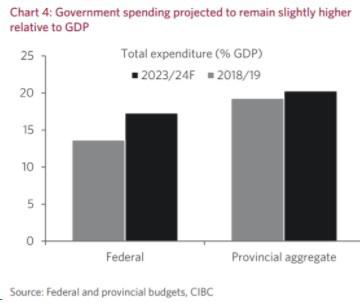
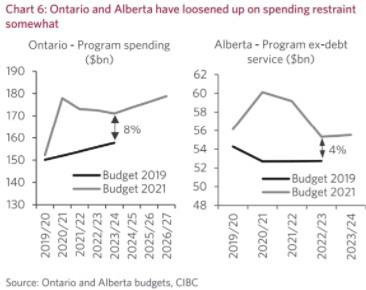
long timelines back to balance shouldn’t be of too much concern to buyers of provincial bonds. For one, markets and rating agencies have already had months to digest this news and incorporate it into spreads and ratings outlooks. And importantly, the latest round of provincial budgets were based on very conservative forecasts for economic growth and by extension provincial revenues.
BORROWING REQUIREMENTS HEADING LOWER
Budget beats will mean that less deficit funding is required, therefore lowering the projected size of borrowing programs this year. That notion of reduced supply, which translates into lower overall debt, is the key driver of tighter spreads. Some provinces are already seeing these improvements in their coffers. That could explain why they are allowing themselves to lag behind the pace they would need if they had to reach their budget borrowing plan. British Columbia, having more conservative assumptions, is significantly lagging having only completed 14.0% of their previously stated programs, respectively (Table 1). The releases of 2020/21 public accounts are solidifying this point. The trend of improving forecasts, which we see as our base case for many of the provinces, has us lowering our expectations for overall supply.
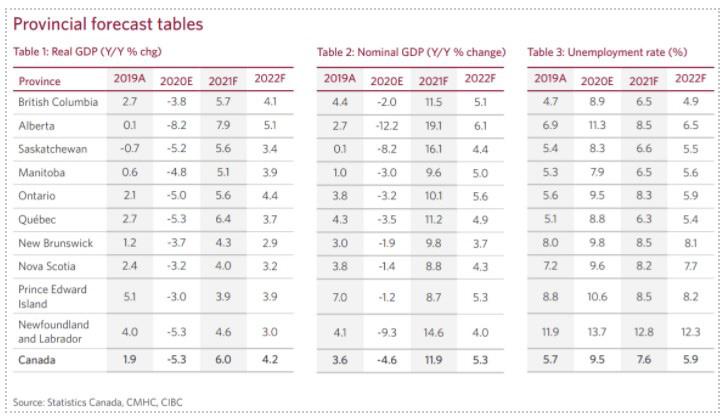
Continued next page.







